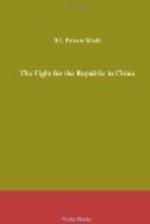If the situation which arose on the 15th August, 1914, is to be thoroughly understood, it is necessary to pick up threads of Chino-Japanese relations from a good many years back. First-hand familiarity with the actors and the scenes of at least three decades is essential to give the picture the completeness, the brilliancy of colouring, and withal the suggestiveness inseparable from all true works of art. For the Chino-Japanese question is primarily a work of art and not merely a piece of jejune diplomacy stretched across the years. As the shuttle of Fate has been cast swiftly backwards and forwards, the threads of these entwining relations have been woven into patterns involving the whole Far East, until to-day we have as it were a complete Gobelin tapestry, magnificent with meaning, replete with action, and full of scholastic interest.
Let us follow some of the tracery. It has long been the habit to affirm that the conflict between China and Japan had its origin in Korea, when Korea was a vassal state acknowledging the suzerainty of Peking; and that the conflict merited ending there, since of the two protagonists contending for empire Japan was left in undisputed mastery. This statement, being incomplete, is dangerously false. Dating from that vital period of thirty years ago, when Yuan Shih-kai first went to Seoul as a general officer in the train of the Chinese Imperial Resident (on China being forced to take action in protection of her interests, owing to the “opening” of Korea by the American Treaty of 1882) three contestants, equally interested in the balance of land-power in Eastern Asia were constantly pitted against one another with Korea as their common battling-ground—Russia, China and Japan. The struggle, which ended in the eclipse of the first two, merely shifted the venue from the Korean zone to the Manchurian zone; and from thence gradually extended it further and further afield until at last not only was Inner Mongolia and the vast belt of country fronting the Great Wall embraced within its scope, but the entire aspect of China itself was changed. For these important facts have to be noted. Until the Russian war of 1904-05 had demonstrated the utter valuelessness of Tsarism as an international military factor, Japan had been almost willing to resign herself to a subordinate role in the Far East. Having eaten bitter bread as the result of her premature attempt in 1895 (after the Korean war) to become a continental power—an attempt which had resulted in the forced retrocession of the Liaotung Peninsula—she had been placed on her good behaviour, an attitude which was admirably reflected in 1900 when her Peking Expeditionary Force proved itself so well-behaved and so gallant as to arouse the world’s admiration. But the war with Russia and the collapse of the Tsar’s Manchurian adventure not only drew her back into territory that she never hoped to see again, but placed her in possession of a ready-made railway system which carried her almost




